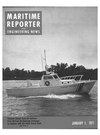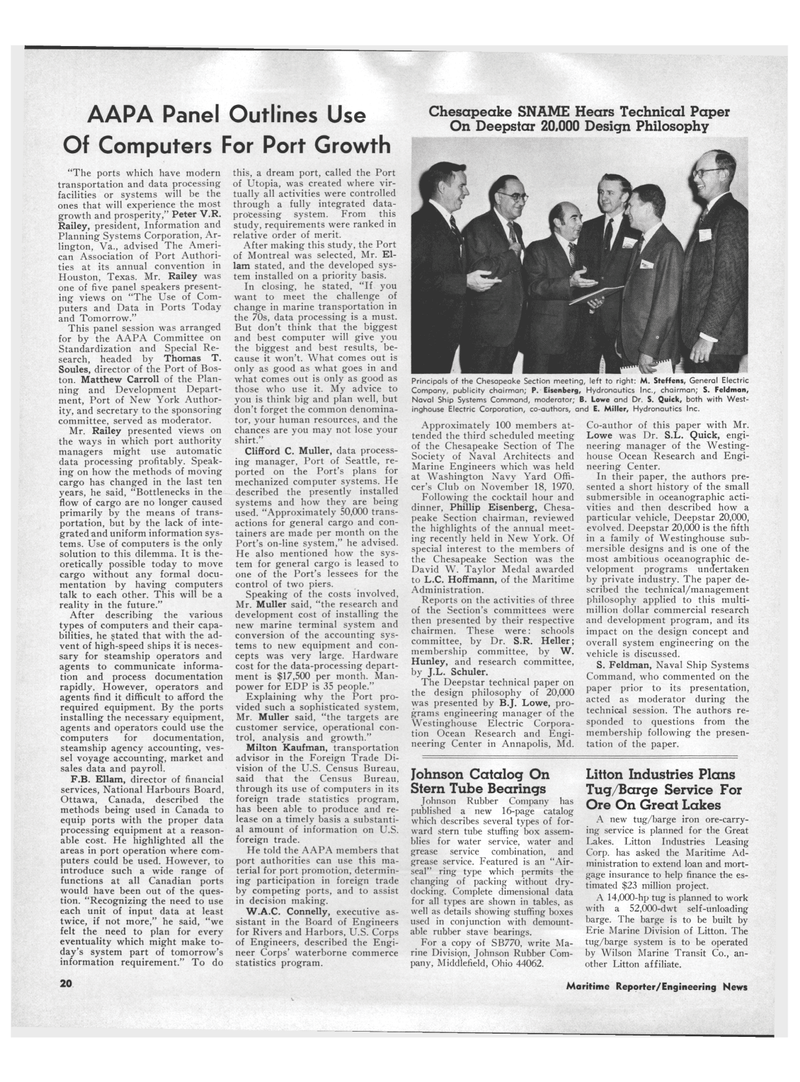
Page 18: of Maritime Reporter Magazine (January 1971)
Read this page in Pdf, Flash or Html5 edition of January 1971 Maritime Reporter Magazine
AAPA Panel Outlines Use
Of Computers For Port Growth
Chesapeake SNAME Hears Technical Paper
On Deepstar 20,000 Design Philosophy
Principals of the Chesapeake Section meeting, left to right: M. Steffens, General Electric
Company, publicity chairman; P. Eisenberg, Hydronautics Inc., chairman; S. Feldman,
Naval Ship Systems Command, moderator; B. Lowe and Dr. S. Quick, both with West- inghouse Electric Corporation, co-authors, and E. Miller, Hydronautics Inc. "The ports which have modern transportation and data processing facilities or systems will be the ones that will experience the most growth and prosperity," Peter V.R.
Railey, president, Information and
Planning Systems Corporation, Ar- lington, Va., advised The Ameri- can Association of Port Authori- ties at its annual convention in
Houston, Texas. Mr. Railey was one of five panel speakers present- ing views on "The Use of Com- puters and Data in Ports Today and Tomorrow."
This panel session was arranged for by the AAPA Committee on
Standardization and Special Re- search, headed by Thomas T.
Soules, director of the Port of Bos- ton. Matthew Carroll of the Plan- ning and Development Depart- ment, Port of New York Author- ity, and secretary to the sponsoring committee, served as moderator.
Mr. Railey presented views on the ways in which port authority managers might use automatic data processing profitably. Speak- ing on how the methods of moving cargo has changed in the last ten years, he said, "Bottlenecks in the flow of cargo are no longer caused primarily by the means of trans- portation, but by the lack of inte- grated and uniform information sys- tems. Use of computers is the only solution to this dilemma. It is the- oretically possible today to move cargo without any formal docu- mentation by having computers talk to each other. This will be a reality in the future."
After describing the various types of computers and their capa- bilities, he stated that with the ad- vent of high-speed ships it is neces- sary for steamship operators and agents to communicate informa- tion and process documentation rapidly. However, operators and agents find it difficult to afford the required equipment. By the ports installing the necessary equipment, agents and operators could use the computers for documentation, steamship agency accounting, ves- sel voyage accounting, market and sales data and payroll.
F.B. Ellam, director of financial services, National Harbours Board,
Ottawa, Canada, described the methods being used in Canada to equip ports with the proper data processing equipment at a reason- able cost. He highlighted all the areas in port operation where com- puters could be used. However, to introduce such a wide range of functions at all Canadian ports would have been out of the ques- tion. "Recognizing the need to use each unit of input data at least twice, if not more," he said, "we felt the need to plan for every eventuality which might make to- day's system part of tomorrow's information requirement." To do this, a dream port, called the Port of Utopia, was created where vir- tually all activities were controlled through a fully integrated data- processing system. From this study, requirements were ranked in relative order of merit.
After making this study, the Port of Montreal was selected, Mr. El- lam stated, and the developed sys- tem installed on a priority basis.
In closing, he stated, "If you want to meet the challenge of change in marine transportation in the 70s, data processing is a must.
But don't think that the biggest and best computer will give you the biggest and best results, be- cause it won't. What comes out is only as good as what goes in and what comes out is only as good as those who use it. My advice to you is think big and plan well, but don't forget the common denomina- tor, your human resources, and the chances are you may not lose your shirt."
Clifford C. Muller, data process- ing manager, Port of Seattle, re- ported on the Port's plans for mechanized computer systems. He described the presently installed systems and how they are being used. "Approximately 50,000 trans- actions for general cargo and con- tainers are made per month on the
Port's on-line system," he advised.
He also mentioned how the sys- tem for general cargo is leased to one of the Port's lessees for the control of two piers.
Speaking of the costs involved,
Mr. Muller said, "the research and development cost of installing the new marine terminal system and conversion of the accounting sys- tems to new equipment and con- cepts was very large. Hardware cost for the data-processing depart- ment is $17,500 per month. Man- power for EDP is 35 people."
Explaining why the Port pro- vided such a sophisticated system,
Mr. Muller said, "the targets are customer service, operational con- trol, analysis and growth."
Milton Kaufman, transportation advisor in the Foreign Trade Di- vision of the U.S. Census Bureau, said that the Census Bureau, through its use of computers in its foreign trade statistics program, has been able to produce and re- lease on a timely basis a substanti- al amount of information on U.S. foreign trade.
He told the AAPA members that port authorities can use this ma- terial for port promotion, determin- ing participation in foreign trade by competing ports, and to assist in decision making.
W.A.C. Connelly, executive as- sistant in the Board of Engineers for Rivers and Harbors, U.S. Corps of Engineers, described the Engi- neer Corps' waterborne commerce statistics program.
Approximately 100 members at- tended the third scheduled meeting of the Chesapeake Section of The
Society of Naval Architects and
Marine Engineers which was held at Washington Navy Yard Offi- cer's Club on November 18, 1970.
Following the cocktail hour and dinner, Phillip Eisenberg, Chesa- peake Section chairman, reviewed the highlights of the annual meet- ing recently held in New York. Of special interest to the members of the Chesapeake Section was the
David W. Taylor Medal awarded to L.C. Hoffmann, of the Maritime
Administration.
Reports on the activities of three of the Section's committees were then presented by their respective chairmen. These were: schools committee, by Dr. S.R. Heller; membership committee, by W.
Hunley, and research committee, by J.L. Schuler.
The Deepstar technical paper on the design philosophy of 20,000 was presented by B.J. Lowe, pro- grams engineering manager of the
Westinghouse Electric Corpora- tion Ocean Research and Engi- neering Center in Annapolis, Md.
Johnson Catalog On
Stern Tube Bearings
Johnson Rubber Company has published a new 16-page catalog which describes several types of for- ward stern tube stuffing box assem- blies for water service, water and grease service combination, and grease service. Featured is an "Air- seal" ring type which permits the changing of packing without dry- docking. Complete dimensional data for all types are shown in tables, as well as details showing stuffing boxes used in conjunction with demount- able rubber stave bearings.
For a copy of SB770, write Ma- rine Division, Johnson Rubber Com- pany, Middlefield, Ohio 44062.
Co-author of this paper with Mr.
Lowe was Dr. S.L. Quick, engi- neering manager of the Westing- house Ocean Research and Engi- neering Center.
In their paper, the authors pre- sented a short history of the small submersible in oceanographic acti- vities and then described how a particular vehicle, Deepstar 20,000, evolved. Deepstar 20,000 is the fifth in a family of Westinghouse sub- mersible designs and is one of the most ambitious oceanographic de- velopment programs undertaken by private industry. The paper de- scribed the technical/management philosophy applied to this multi- million dollar commercial research and development program, and its impact on the design concept and overall system engineering on the vehicle is discussed.
S. Feldman, Naval Ship Systems
Command, who commented on the paper prior to its presentation, acted as moderator during the technical session. The authors re- sponded to questions from the membership following the presen- tation of the paper.
Litton Industries Plans
Tug/Barge Service For
Ore On Great Lakes
A new tug/barge iron ore-carry- ing service is planned for the Great
Lakes. Litton Industries Leasing
Corp. has asked the Maritime Ad- ministration to extend loan and mort- gage insurance to help finance the es- timated $23 million project.
A 14,000-hp tug is planned to work with a 52,000-dwt self-unloading barge. The barge is to be built by
Erie Marine Division of Litton. The tug/barge system is to be operated by Wilson Marine Transit Co., an- other Litton affiliate. 20 Maritime Reporter/Engineering Hews

 17
17

 19
19
